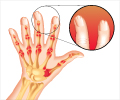The Childhood Arthritis and Rheumatology Research Alliance (CARRA) developed the consensus treatment plan (CTP) approach as a comparative effectiveness tool.

‘Consensus treatment plans (CTP) are treatment strategies intended to reduce variation in treatment approaches, standardize outcome measurements, and allow for comparison of the effectiveness of different approaches with the goal of improving disease outcomes.’





Pediatric rheumatic diseases are a varied group of rare diseases including juvenile forms of arthritis, lupus, fibromyalgia, and other conditions. Currently, there is considerable variability in how patients with these diseases are treated in clinical practice, making it difficult to understand which therapies work best. A recent review article published in Arthritis & Rheumatology examines recent efforts to address this challenge.Ideally, randomized placebo-controlled clinical trials are conducted to help determine the best course of action against a disease, but such trials are difficult to perform in rare diseases. Consensus treatment plans (CTPs) are a potential alternative. CTPs are standardized strategies that are developed by a consensus among experts and are intended to help reduce treatment variability and allow for comparisons of different therapies. The Childhood Arthritis and Rheumatology Research Alliance (CARRA), the largest pediatric rheumatology research collaborative in North America, is pioneering the use of CTPs to standardize the common treatments for pediatric rheumatic diseases.
In their review, Sarah Ringold, MD, MS, of Seattle Children's Hospital, and her colleagues present the rationale for the CARRA CTP approach, consider its advantages and disadvantages, and introduce related ongoing research.
"Once a diagnosis is made, providers and patients and their families can choose together the CTP strategy that they believe will work the best for that disease," Dr. Ringold explained. "Information on how the patient is doing on that treatment is then collected at regular clinic visits through a registry. At the end of the proposed study duration, researchers can then compare how the patients do between the different CTPs."
Dr. Ringold noted that ongoing large-scale studies are testing this approach in juvenile idiopathic arthritis. Results from these studies will provide more information on the feasibility of this approach and may provide insights on which therapeutic strategies are most likely to be successful for certain patients. "The CTP approach will be even more powerful when coupled with biospecimen collection to facilitate translational research aimed at identifying biomarkers of response and non-response, paving the way towards personalized medicine," she said.
Advertisement









